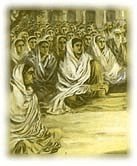They Died Saving Each Other...
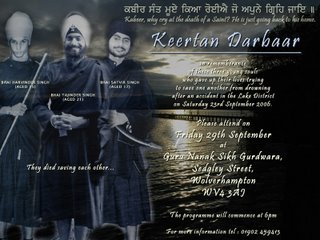 Three bodies recovered from lakeThe bodies of three youths have been recovered from Ullswater in the Lake District, police said.
Three bodies recovered from lakeThe bodies of three youths have been recovered from Ullswater in the Lake District, police said.The three, aged 15, 17 and 21 and from the West Midlands, were among a group enjoying a swim when one of them got out of their depth. Another 15-year-old boy had to be pulled to safety during the incident at about 1600 BST on Saturday.
Police said conditions were reasonably calm, but there were deep areas and the water was very cold.They said they were contacting the families of those who died before releasing any more information.A Cumbria Police spokesman said: "Police have now recovered the three bodies of the males who went missing in Ullswater lake.
"We are in the process of contacting the deceased males' families and updating them regarding the circumstances of the drowning."No details will be released until all family members have been informed regarding this tragic incident."
'Extremely cold'Members of the public and a lake warden went to help when the alarm was raised, and managed to rescue the 15-year-old boy.He was taken to hospital, where his injuries were not thought to be life-threatening.
Searches by the coastguard, a helicopter and police and civilian divers were carried out overnight.
Police said the boys were part of a group staying in Glenridding, a village overlooking Ullswater.
Insp Sean Murphy, from Cumbria Police, said: "I think the lake was reasonably calm."
Unfortunately it does have deep areas and shelving and the water is extremely cold so it's all speculation at the moment but I am assuming that someone has gone too deep and they have got cold and been unable to swim."
pi(n)dd mooai jeeo kih ghar jaathaa
When the body dies, where does the soul go?
sabadh atheeth anaahadh raathaa
It is absorbed into the untouched, unstruck melody of the Word of the Shabad.
jin raam jaaniaa thinehi pashhaaniaa
Only one who knows the Lord realizes Him.
jio goo(n)gae saakar man maaniaa 1
The mind is satisfied and satiated, like the mute who eats the sugar candy and just smiles, without speaking. 1
aisaa giaan kathhai banavaaree
Such is the spiritual wisdom which the Lord has imparted.
man rae pavan dhrirr sukhaman naaree 1 rehaao
O mind, hold your breath steady within the central channel of the Sushmanaa. 1Pause
so gur karahu j bahur n karanaa
Adopt such a Guru, that you shall not have to adopt another again.
so padh ravahu j bahur n ravanaa
Dwell in such a state, that you shall never have to dwell in any other.
so dhhiaan dhharahu j bahur n dhharanaa
Embrace such a meditation, that you shall never have to embrace any other.
aisae marahu j bahur n maranaa 2
Die in such a way, that you shall never have to die again. 2
oulattee ga(n)gaa jamun milaavo
Turn your breath away from the left channel, and away from the right channel, and unite them in the central channel of the Sushmanaa.
bin jal sa(n)gam man mehi nhaavo
At their confluence within your mind, take your bath there without water.
lochaa samasar eihu biouhaaraa
To look upon all with an impartial eye - let this be your daily occupation.
thath beechaar kiaa avar beechaaraa 3
Contemplate this essence of reality - what else is there to contemplate? 3
ap thaej baae prithhamee aakaasaa
Water, fire, wind, earth and ether
adopt such a way of life and you shall be close to the Lord.
kehai kabeer nira(n)jan dhhiaavo
Says Kabeer, meditate on the Immaculate Lord.
thith ghar jaao j bahur n aavo 418
Go to that home, which you shall never have to leave. 418
Do Ardass for the Sangat and the families who were blessed to know three young Chardi Kala Gursikhs, and pray for the Sangat and the families to have the strength to commemorate the lives of three blessed souls!
The Great Rani Sada Kaur...
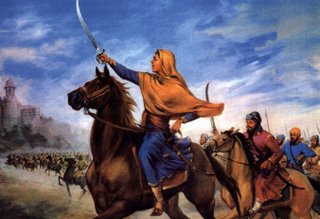 During the times of Sikhs Misls, the Sikhs were badly disunited. They successfully destroyed the aggressors but now they were fighting amongst themselves. All Sardaars (chieftains) were trying to destroy each other to extend their kingdoms. After the death of Sardar Gurbaksh Singh in a fight with one of the misls, his wife, Sardarni Sada Kaur took over the reins of her misl.
During the times of Sikhs Misls, the Sikhs were badly disunited. They successfully destroyed the aggressors but now they were fighting amongst themselves. All Sardaars (chieftains) were trying to destroy each other to extend their kingdoms. After the death of Sardar Gurbaksh Singh in a fight with one of the misls, his wife, Sardarni Sada Kaur took over the reins of her misl.The Singhpuria Misl had great enmity with Sardar Gurbaksh Singh. After his death, his wife Sardarni Sada Kaur like a warrior kept her position fortified thus resulting in the Singhpuriya Misl Sardar becoming her sworn enemy. He always looked for an opportunity to win over Sardarni Sada Kaur. His intelligence agents were always behind Sardarni Sada Kaur to watch her activities.
On the other side Sardarni Sada Kaur was no less vigilant than the Singhpuriya Sardar. She always ensured that she was well-protected and always went out with no less than few hundred soldiers protecting her. The history stands witness to the fact that not only she was able to save her honour and position but she played a leading role in boosting the power of her son-in-law Raja Ranjit Singh. She fought along with Raja Ranjit Singh in all his big battles.
This incident that we are going to narrate is long before she become a relative of Raja Ranjit Singh. Once Sardarni Sada Kaur decided to visit Siri Darbar Sahib – Amritsar Sahib. She took her guards and a small army and reached Siri Amritsar Sahib. At the same time as a coincidence the Singhpuriya Sardar too reached Siri Amritsar Sahib at the same time as Sardarni Sada Kaur. Both had similar aim of visiting Siri Darbar Sahib i.e. to do ishnaan in the sacred sarovar – Ramdas Sarovar and to pay obeisance at Siri Harmandir Sahib.
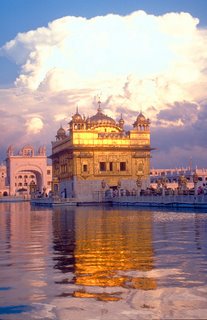 The Singhpuria Sardar after doing ishnaan went inside Siri Darbar Sahib to matha tek and listen to kirtan. Right at that time, Sardarni Sada Kaur reached the Parkarma of Sarovar and went inside the ladies section to do ishnaan. While she was taking ishnaan (ablutions) her maids were standing outside and the Singhpuria agents realized quickly that Sardarni Sada Kaur was inside the ishnaan porch all alone. The agents whispered in ears about the presence of Sardarni jee and by then the maids standing outside too realized that the Singhpuriya sardaar was here and that his agents had found out that Sardarni Sada Kaur was all by herself and defenceless at Darbar Sahib.
The Singhpuria Sardar after doing ishnaan went inside Siri Darbar Sahib to matha tek and listen to kirtan. Right at that time, Sardarni Sada Kaur reached the Parkarma of Sarovar and went inside the ladies section to do ishnaan. While she was taking ishnaan (ablutions) her maids were standing outside and the Singhpuria agents realized quickly that Sardarni Sada Kaur was inside the ishnaan porch all alone. The agents whispered in ears about the presence of Sardarni jee and by then the maids standing outside too realized that the Singhpuriya sardaar was here and that his agents had found out that Sardarni Sada Kaur was all by herself and defenceless at Darbar Sahib.
As the agents rushed to inform the Sardar about Sada Kaur being present at Darbar Sahib totally defenceless, the maids dashed inside the ladies area of sarovar to tell Sardarni jee about the possible danger from the Singhpuriya Sardaar.
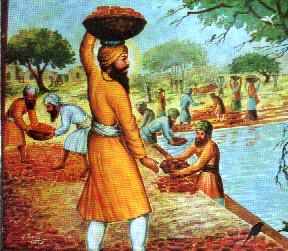
Sardarni Sada Kaur at that time was in some other mood. When the maids informed her of the Singhpuriya Sardar and the imminent danger from him, Sardarni jee with total faith in Guru Sahib responded,
“Look, at this time I am sitting in the heavenly lap of my father Guru Ramdass jee and I am pretty sure that the Singhpuriya sardar will not make the mistake of attacking me in such position. But if he does attack me, then I will not fight and will readily get arrested by him but will not fight back in the premises of Siri Darbar Sahib.”
Then Sardarni told one of her maids to go outside Darbar Sahib and inform her soldiers that they should be prepared for a possible fight outside Darbar Sahib.
After such bold answer, she became oblivious of her surrounding and started doing ishnaan again.
On the other hand, the intelligence agent went to inform the Sardar about Sardarni Sada Kaur being alone and how it was a great opportunity to capture or kill her. The Singhpuriya Sardar was listening to kirtan very keenly. The kirtanees were singing a very bairaagmai shabad that stated the futility of our efforts to collect worldly wealth. Sardaar’s mind had become purified as it was one with shabad.
The soohiya (agent) unaware of the spiritual and mental state of the Sardar, went dashing in Darbar Sahib and even forgot to do matha tek. The only thing in his mind was to get reward for telling the whereabouts of Sardarni Sada Kaur. He did not care about keeping respect of the sangat present there, nor did he realize the message of the shabad being sung. He hurriedly went over to the Sardar and in his ear whispered, “Sardar jee, Rani Sada Kaur at this time is taking ishnaan in the ladies area of the sarovar. She is totally unprotected. This is a great opportunity to kill her or capture her alive”. Sardar’s mann (mind) at that time was totally engrossed in Gurbani and had become pure. He got upset at the action of the soohiya and how he had not cared about keeping respect of Guru and sangat. He thought if this soohiya was only a soohiya and not a Sikh. The soohiya in the meantime was standing by waiting for the Sardar to respond. The sardar keeping fear of Guru whisperingly said,
Sardar’s mann (mind) at that time was totally engrossed in Gurbani and had become pure. He got upset at the action of the soohiya and how he had not cared about keeping respect of Guru and sangat. He thought if this soohiya was only a soohiya and not a Sikh. The soohiya in the meantime was standing by waiting for the Sardar to respond. The sardar keeping fear of Guru whisperingly said,
“Go away from here. You are not fit to stand here in Siri Harmandir Sahib. You did not even care about Guru, Sangat and Siri Harmandir Sahib. You did not care that this was not the right time and place to talk about such lowly thing. You are not a Sikh of Guru. Get away from my eyes”.
Saying this the Sardar came out and ordered one of his soldiers to arrest the soohiya. The sardar came back and started meditating on the shabad of Guru. After some time the Sardar got up and started walking out of Siri Harmandir Sahib.
In the meantime, Sardarni Sada Kaur after finishing her ishnaan, started walking towards Siri Harmandir Sahib. She was standing by Darshani DeoRi and the Sardar came out. Both Sardarni and Sardar were engrossed in baani. There were sworn enemies of each other. When they saw each other, both stopped.
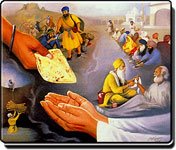
The sardar made the first move. He had Degh (parshaad) in his hands and said fateh to Sardarni jee, “Bhain jee please accept parshaad of Guru Ramdas jee. I had thought that when I come out of Darbar Sahib, I will wait for you to come and give you parshaad. It is my honour and good fortune that you came right at the time I came out of Darbar Sahib. Now please accept parshaad from me”.
Sardarni jee was moved by the humility of the Sardar and said fateh back to him and responded,
“It is my big fortune (Dhan bhaag) that I am receiving parshaad from that veer’s hands whose hands only handle sword. Well! My visit in the hazoor of Guru Ramdas jee has been successful”.
Sardar got emotional and said,
“After listening to the great gift of Guru Sahib to us – Gurbani – I can only derive that we are doing is futile. Only his naam is true and rest is false. Listening to Gurbani brings peace to mind. How foolish are we who indulge in petty enmities and ignore the message of Guru”.
“What you are saying is so true Veer jeeo. For so long we foolishly kept enmity between us. Now Satguru himself has done kirpa on us and we have realized the true path.”
“If you too are thinking along these lines, then Bhain jeeo, let us bury our enmities right now and perform an ardaas before Guru Ramdass jee. Let us make up for the past and from now on live like real brother and sister. Let us reconcile and finish off these problems and enmities created by maaiya”.
“Veer jeeo, you and I are both children of Guru Gobind Singh jee and at this time we are standing in the house of Guru Ramdass jee. If our problems and enmities are not going to get eliminated here, then where would they?”

After this they both sent a message to one of the greatest Granthi of Siri Darbar Sahib – Bhai Sahib Chanchal Singh jee to perform an ardaas for their unity. While they were waiting for Granthi jee to come, they both closed their eyes in Anand of Gurbani and felt immense love and thankfulness for Guru Sahib.
From that day onwards, they stayed like real brother and sister for rest of their lives. Ones who were thirsty for each other’s blood developed so much love for each other that even real biological brother sister cannot do. Such is the shakti of Gurbani and Naam.
It is my ardaas before Satguru to do such miracle on the Sikh panth at this time. We are totally disunited. We need a miracle to get united again. Guru Sahib jeeo, kirpa karo.
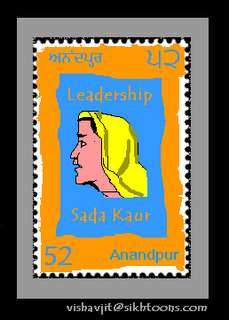
Born in 1762, Sada Kaur was an administrator endowed with the admirable qualities of statesmanship and a courageous warrior.
Sada Kaur played a pivotal role in uniting the Khalsa forces under the command of Ranjit Singh to drive out Afghan invaders. When Ranjit Singh received an invitation from prominent citizens of Lahore to end the misrule of the Afghan invaders and take over the city he sought Sada Kaur's wisdom.
She counseled Ranjit Singh that anyone controlling the capital of the state will inevitably become the master of the Panjab. She however adviced Ranjit Singh to tell his soldiers and commanders not to plunder or inflict suffering on the innocent citizens of Lahore. They were to be instructed to take Lahore not as conquerors but as friends and deliverers.
On June 26, 1799 Ranjit Singh marched towards Lahore with his soldiers. Ranjit Singh entered the city through Lahori Gate and Sada Kaur led her horseman through Delhi Gate. Lahore was taken bloodless with little bloodshed or loss of life.
Source: Sikhtoons, & Kulbir Singh (tapoban.org)
by Dya Singh, Australia

"Because I'm a woman" she told him.
"I don't understand," he said.
His mom just hugged him and said, "And you never will"..........
Later the little boy asked his daddy, "Why does mother seem to cry for no reason?"
"All women cry for no reason" was all his dad could say........
The little boy grew up and became a man, still wondering why women cry. Finally he put in a call to WAHEGURU JI; when He got on the phone, the man asked "O WAHEGURU JI, why do women cry so easily?"
I gave her an inner strength to endure childbirth and the rejection that many times comes from her children.

I gave her a hardness that allows her to keep going when everyone gives up and take care of her family through sickness and fatigue without complaining.
I gave her the sensitivity to love her children under any and all circumstances, even when her child has hurt them very badly.
This same sensitivity helps her make a child's booboo feel better and shares in their teenagers anxieties and fears.

I gave her strength to carry her husband through his faults and fashioned her to protect his heart.
I gave her wisdom to know that a good husband never hurts his wife, but sometimes tests her strengths and her resolve to stand beside him unfalteringly.
I also gave her a tear to shed, It's hers exclusively to use whenever it is needed. It's not her weakness, it is her strength. It's a tear for mankind.
The beauty of a woman is not in the clothes she wears, the figure that she carries, or the way she combs her hair. The beauty of a woman must be seen in her eyes, because that is the doorway to her heart, the place where love resides. True beauty in a woman is reflected in her soul. It is the caring that she lovingly gives the passion that she shows and the beauty of a woman, with passing years, only grows!
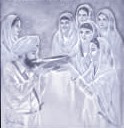
Sources:
Poem: SikhWomen.Com
Pictures: Sikhnet
My first choice, Harpreet Kaur, the director of
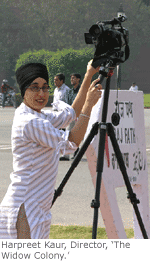 ‘Sikhing’ justice through documentary filmmaking
‘Sikhing’ justice through documentary filmmakingAnger inspired Harpreet Kaur to make a movie. And if this Gaithersburg High School alumna has her way, ‘‘The Widow Colony” will help shake up the Sikh community and the Indian government — and lead them to help change the lives of about 1,200 women and their children now living in a New Delhi slum. The award-winning documentary will be shown Saturday afternoon at the American Film Institute’s Silver Theatre in Silver Spring.
If nothing else, 29-year-old Kaur is passionate. Speaking in rapid-fire staccato, she proclaims, ‘‘India is covering up the issues. The world’s largest democracy is playing games with its people. We want justice.”
Kaur is referring to the massacre of some 4,000 Sikhs in New Delhi in 1984. Since childhood, she had heard stories of the four-day pogrom that followed the assassination of the country’s beloved Prime Minister Indira Gandhi by her two Sikh bodyguards.
“Most of the Sikh women in Trilokpuri who suffered gang rape, were from 9 and 10 year old girls to 80 year old women…” – Gurdip Kaur
While the murderous rampage was bad enough, what happened to the widows and their children since then is equally disturbing. India has never been kind to poor widows, no matter their age or religion. The subject is depicted in the feature film ‘‘Water,” in which widows as young as 8 years old are banished from their community. Of course, these Sikh women were marked for life, with their broken families quickly herded to the west side of New Delhi into what the country called ‘‘India’s Unsettled Settlement,” where they live in abject poverty, often begging for food. With only each other to rely on, they continue to relive 1984, Kaur observes.
"...A moving and emotional depiction of the trauma that still haunts innumerable widows of the Sikh massacre, the film unearths the sad and deplorable condition most of these widows are living in the vidhva (widow) colonies of Delhi..."
“...Described by critics as the “most affecting” documentary to come out of India since Born into Brothels…”
Kaur was raised in sleepy suburban Gaithersburg, earning a degree in communications from Pennsylvania State University. After working as a broadcaster for Montgomery County’s Channel 21, she left her job to pursue documentary filmmaking in 2003. Since her husband works for IBM and only needs a laptop to do his job, they moved near friends in Austin, Texas, where the cost of living is lower, and she began working on the film.
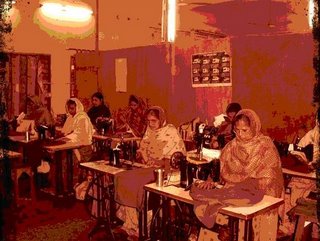
With charge cards in hand, the couple traveled to India twice to film the women. At first, the victims weren’t exactly happy to talk to this tiny film crew. Over two decades, many others had come asking questions. After years of relaying their stories to reporters and seeing no results, they were leery about revisiting the issue with another outsider. Once Kaur explained her intention to create a film that would be seen in India and abroad, they started talking. After completing the film, she returned to India and offered a special showing of the film for the victims, who, she says, were satisfied with the result.
"...The final product is a gut-wrenching tale of what has become of the survivors of the 1984 pogroms against the Sikhs of New Delhi..."
– SIKHNN
This experience took an emotional toll on Kaur. During two trips to India, she and her husband spent long days interviewing and taping 20 widows. Staying with family, she says they would come home late ‘‘burned out mentally. We needed to be quiet at night.” Often Kaur cried herself to sleep.
Her family couldn’t understand what all the fuss was about, figuring that along with filming, the young couple was out touring during the day. Finally, she brought a cousin along on a shoot, and he was stunned that these women lived just 15 minutes from his home
‘‘He didn’t even know they existed,” she recalls.
She hopes this 73-minute documentary will be a catalyst for change.
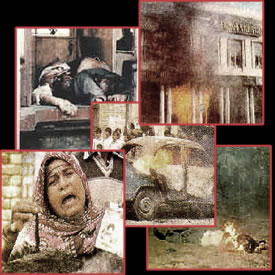 “Unless the voices of survivors are heard and recorded, history will eclipse their narratives and the silenence of impunity will prevail…”
“Unless the voices of survivors are heard and recorded, history will eclipse their narratives and the silenence of impunity will prevail…”
-Jaskaran Kaur, Executive Director, ENSAAF
http://www.thewidowcolony.com/
"...A historical record of a carnage, the biggest-ever massacre anywhere in India, of how 4000 Sikhs were roasted alive in three days in November 1984, right in the Capital of “the World’s largest democracy”, of how mobs led by members of the “secular” Congress party had a free run of Delhi, as the police either looked the other way or disarmed & arrested the Sikhs who acted in self – defence, of how the state and its agencies deflected all attempts over the years to secure justice for the victims..."
– Carnage ‘84
Source: ‘Sikhing’ justice through documentary filmmaking by Karen Schafer
Filmmaker/Director/Writer:
Harpreet Kaur
Producer:
Manmeet Singh
I hope the Sangat has enjoyed learning about Harpreet Kaur, and her Project “The Widow Colony.” It’s a great pleasure to see how many Kaurs have succeeded in today’s world with many goals. If you have any suggestions for a blog entry of a Kaur (or Singh) please let me know by e-mail (faujkaur@hotmail.com) or leave a comment on the blog entry.
Waheguru Ji Ka Khalsa! Waheguru Ji Ke Fateh!!
If your children were taken from you....ripped apart in front of your eyes.....
Then their cut up bodies strung around your neck......
Would you continue to remember your Guru??
How strong and magnificent were the Mothers and Daughters of the Khalsa Panth....
In the first half of the 18th century, state terrorism against the Sikhs was on the steady increase and was intensified by Mir Mannu, the new Governor of Lahore (1748-1753). By now the faith of the common people in Sikhi and the strength of the Khalsa had increased tremendously. Despite Mannu's extreme torture and reign of terror, nothing could deter the Sikhs. A Panjabi folk song of that period goes like this in English:
We are the plants and Mannu a sickle,
But by now, everyone knows,
The more he cuts us, the more we grow.
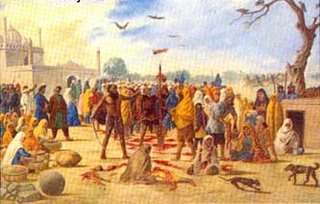 This is the time when the army of Mir Mannu was going from house to house searching for Sikhs. Many of the Sikhs took shelter in jungles but some Sikhs who were living with their families in the cities and could not just leave right away or join any jathas. They were captured by the army and all were being sent to Lahore. Most of the prisoners were Sikh women and children. Many of the old women were killed on the way because they were weak and could not walk for a long time. All of the Singhnis and their children were put in Lahore jail. For labor they were given “chakkis”. They were given no food or water. This was a way to torture them so they would leave Sikhi. They were separated from their children.
This is the time when the army of Mir Mannu was going from house to house searching for Sikhs. Many of the Sikhs took shelter in jungles but some Sikhs who were living with their families in the cities and could not just leave right away or join any jathas. They were captured by the army and all were being sent to Lahore. Most of the prisoners were Sikh women and children. Many of the old women were killed on the way because they were weak and could not walk for a long time. All of the Singhnis and their children were put in Lahore jail. For labor they were given “chakkis”. They were given no food or water. This was a way to torture them so they would leave Sikhi. They were separated from their children.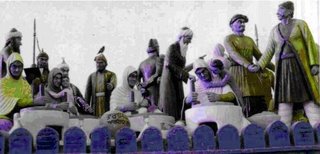
Everyday muslims would come and taunt them by saying “where is your Khalsa now? They can’t even come to rescue you. All of them have been killed by the army. So it is better for you to accept Islam and live a rich happy life.” Singhnis never ever thought of leaving Sikhi. They kept reciting “Waheguru Dhan Guru Waheguru Waheguru”.
All children were separated from their mothers and were given no food or water. Then muslims started killing the innocent children by throwing them up in the air and landing them on sharp spears. Some children were cut into pieces and garlands were made out of their pieces. Then they put those garlands around the necks of Sikh mothers. But the faith of Sikh women was unshakable. One of the women was very beautiful and Qazi wanted to marry her. He would come everyday and try to convince her to accept him but she never did. She had a son who was less than two years old. One day upon leaving, qazi gave orders to some of the army men to torture her and her son so she would give up her faith.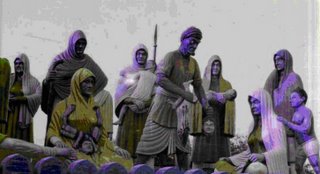
One night the cruel animals (men) tied her up first and then started torturing her son. They hung her son upside down, took a knife and started to cut into his flesh from the neck all the way down to stomach. Singhni kept calm and kept praying “Guru Ji, Jaan Jayai par Dharam Na Jaayai”. Then they slowly cut her son into pieces and he became shaheed. Then they started beating the Singhni with sticks and “chabuks”. After a while the Singhni passed out. They hung her upside down and left. She stayed that way all night. In the morning they took her down but she was unable to get up and walk. She lay there by the wall, did Nitnem and then did ardaas
“Sacchay Paatshah Ji, Saari Raat Aap De Bhanay tay Sukh Naal Beetee Hai. Aap ji da kotaan kot shukar hai, aap jee nay aapnee amanat vaapas lai layee hai. Aggay waastay vee bhanay vich chalan da uddam ball bakhsis karna. Daata Ji, praan jayai par Sikhi na jayai. Mehar karni”
 In short, Plight of the Sikh ladies detained in the camps of Mir Mannu was miserable. They were tortured and kept thirsty and hungry as they refused to be converted to Islam. Every one of them was allotted a small millstone to grind a fixed quantity of wheat. It was ordered that the children of these ladies be snatched. One soldier threw a child up in the air and the other killed him with his spear before he could touch the ground. The dead bodies of these children were cut into pieces and the ladies were garlanded with those pieces. Pieces of flesh of the children were thrust into the mouth of their mothers. In spite of all that, none of the ladies cried or yielded to embrace Islam Once this horrible scene stunned Mir Mannu. When he reached the palace after visiting the camp, he did not talk to anybody. It seemed he repented. He left for hunting with only four soldiers. While he was hunting, his horse was scared, ran very fast and jumped so high that Mir Mannu could not control it. He fell down, and his feet got entangled in stirrip. Mir Mannu’s cries further scared the horse and it ran faster. It was dragging Mir Mannu and none could stop it. Mir Mannu was badly injured and died in the forest.
In short, Plight of the Sikh ladies detained in the camps of Mir Mannu was miserable. They were tortured and kept thirsty and hungry as they refused to be converted to Islam. Every one of them was allotted a small millstone to grind a fixed quantity of wheat. It was ordered that the children of these ladies be snatched. One soldier threw a child up in the air and the other killed him with his spear before he could touch the ground. The dead bodies of these children were cut into pieces and the ladies were garlanded with those pieces. Pieces of flesh of the children were thrust into the mouth of their mothers. In spite of all that, none of the ladies cried or yielded to embrace Islam Once this horrible scene stunned Mir Mannu. When he reached the palace after visiting the camp, he did not talk to anybody. It seemed he repented. He left for hunting with only four soldiers. While he was hunting, his horse was scared, ran very fast and jumped so high that Mir Mannu could not control it. He fell down, and his feet got entangled in stirrip. Mir Mannu’s cries further scared the horse and it ran faster. It was dragging Mir Mannu and none could stop it. Mir Mannu was badly injured and died in the forest.
Daughters of the Khalsa, in your strength our future lies!
Learn about the Great Spirit of which Sikhs possess, which no one could ever understand.
This Spiritual Strength derives from Guru Maharaj (Guru Granth Sahib Ji). It's from Gurbani, Naam Simran, Seva and saacha pyar for the Guru.
Give our children fearless minds to see the world through the Guru's eyes!
Let our future brothers and sisters strive to become the Khalsa and continue to inspire others by becoming noble, fearless and Chardi-Kala (high-spirited) Sikhs.
Let them live up to the standards of those countless Sikhs who spilled blood and laid down their heads for the Khalsa to remain distinct and in ever-existence!
Dedicated to the sacred, gracious and benevolent memory of our Divine Father SRI GURU GOBIND SINGH SAHIB and our Divine Mother MATA SAHIB KAUR and those brave Sikh women, who suffered untold oppression in Mir Mannu's prison, who starved and suffered under force labour, and saw their little children cut to pieces, and flung savagely into their laps, yet they still upheld the dignity of Sikhi until their last breath. Their Immortal achievements remain an inspiration to us all for generations to come!
Source
Mir Mannu: Sikh Sakhian at SikhSangat
Pictures: Sikh websites
Daughters of the Khalsa Poem: Written by Ishpinder Kaur (with the help of her sisters Sakhijinder Kaur and Sukhbir Kaur)-Click Here to View

